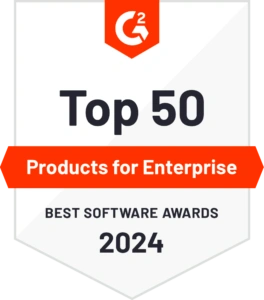Are you confident your sanctions screening program would pass a surprise audit? Most trade compliance managers can’t answer that confidently. You’re screening names, logging results, and meeting deadlines but deep down, there’s a question you can’t answer confidently: Is your sanctions screening truly effective?
In a world of increasing enforcement and complex regulations, simply having a program isn’t enough. Without a clear benchmark for trade compliance, you’re essentially navigating in the dark and that’s a risky place to be when auditors come knocking.
Key Takeaways
- Sanctions screening without a recognized benchmark leaves organizations exposed. Most programs “operate” but can’t prove effectiveness to auditors without an external standard.
- The Wolfsberg Sanctions Screening Guidance has become the de-facto global benchmark. Originally designed for banks, it’s now being adopted across trade, logistics, and global supply chains because of its rigour and structure.
- Regulators now expect defensible, risk-based screening not tick-box compliance. Companies must show how and why decisions were made, with evidence they can stand behind in an audit.
- Descartes Visual Compliance aligns with and exceeds Wolfsberg principles. Through advanced matching logic, AI-assisted screening, auditable workflows, and enhanced risk data, it helps organizations meet and surpass benchmark expectations.
- Benchmarking transforms compliance from a cost center into a strategic capability. It enables better board reporting, stronger regulator confidence, and informed investment decisions.
Trade Compliance Without a Benchmark
Most organizations think their sanctions screening is fine. They run names against denied party lists, check for flagged entities and hope for the best but hope isn’t control. The truth is, many sanctions screening programs lack a clear benchmark to measure effectiveness. And if you can’t measure it, you can’t prove it, especially not to an auditor.
Imagine an auditor asks: “Why did you clear these potential matches? How do you know your screening logic catches everything it should?” If you don’t have solid answers, you’re exposed.
Regulators worldwide are raising expectations. They expect companies to demonstrate sanctions compliance maturity, not just check a box. Without a credible standard to measure against, even a well-intentioned compliance program can fall short of regulatory scrutiny and the consequences of an audit failure (fines, sanctions, reputational damage) loom large.
Why Trade Compliance Needs a Benchmark
Regulators have made it clear that ignorance or “good enough” efforts won’t defend you in an enforcement action. Imagine discovering after an audit that a major weakness in your process allowed a sanctioned party to slip through. The findings could result in hefty fines or even the suspension of your trading privileges. For a compliance manager, the professional fallout can be just as scary. Nobody wants to be the person who “should have caught it.”
Recent enforcement trends show regulators are unafraid to penalize companies for inadequate screening and controls. They are comparing company programs against stringent sanctions screening standards.
So, what’s the solution? The Wolfsberg Sanctions Screening Guidance. Think of Wolfsberg as the global gold standard for sanctions screening programs. Originally crafted for banks, it has quickly become the benchmark for trade compliance across industries. Understandably, because banks are still subject to very high compliance requirements. Other industries are adopting it, because it’s comprehensive, risk based, and rigorously tested in the real world of compliance. Wolfsberg outlines 16 key principles for effective screening covering everything from risk assessment and governance to screening logic, alert handling, and data quality. Adhering to these principles isn’t just a theoretical exercise, it’s viewed as a marker of a credible compliance program.
The Wolfsberg Guidance asks if your sanctions screening program:
- Risk Based – Are you tailoring the screening to your organization’s risk profile, or using a one-size-fits-all approach?
- Technology Enabled – Are you relying on outdated manual checks, or using intelligent software that can handle fuzzy matching, transliterations, and large volumes of data?
- Embedded in Operations- Is screening built into your daily workflows with proper governance, or is it an ad-hoc process?
If you can confidently answer “yes” to all of the above, you’re likely aligned with Wolfsberg’s global sanctions screening standards. If not, you likely have gaps to fill. The Wolfsberg principles give you a clear, credible checklist to evaluate your program so that there is an objective measure to benchmark your trade compliance efforts against a worldwide standard. No more guesswork or hoping you’re on par with peers, you can know for sure.
Exceeding the Standard with Descartes Visual Compliance
Recognizing the value of Wolfsberg’s benchmark is step one. Regulators now expect clear governance, traceable decisions, and systems that can be tested.
Step two is implementing those 16 principles so you can achieve them seamlessly. Here are a few examples that show how Descartes Visual Compliance™ aligns with and even exceeds Wolfsberg Guidance:
- Risk-Based Screening
Wolfsberg expects screening to match your risk profile. Descartes delivers that with configurable list selection, adjustable fuzzy and phonetic logic (and many other screening tuning parameters), and field-level controls. Your process stays focused on what matters most, not buried in noise.
- Technology Fit-for-Purpose
Advanced matching logic, artificial intelligence (AI)-assisted screening, and automatic logging make every decision traceable. When auditors ask “why was this cleared?”, you have the evidence timestamped, documented, and defensible. Audit readiness is built in.
- Alert Handling
Compliance workflows let you triage, escalate, and resolve alerts efficiently all tracked from start to finish. No spreadsheets. No silos. Just a central, auditable record of how each decision was made. - Metrics and Oversight
Dashboards reveal patterns in false positives, resolution times, and hit trends so you can test and improve continuously. Full transparency supports independent validation and regulator confidence.
How Descartes Visual Compliance Sets the Standard
Knowing the benchmark is one thing. Meeting it day after day is another. Here’s how Descartes Visual Compliance maps directly to the key Wolfsberg Sanctions Screening Guidance:
| Wolfsberg Principle | Descartes Visual Compliance Capability | Alignment |
| Risk-Based Approach | Profile-specific screening logic, conditional fields, custom list selection | Fully aligned |
| Technology Fit-for-Purpose | Advanced fuzzy, phonetic, weighted, and Multiple-Orientated Text Recognition (MOTR) logic | Exceeds |
| Match Quality | AI-based confidence scoring and alert suppression | Exceeds |
| Governance & Auditability | Role-based access, workflow tracking, and audit logs | Fully aligned |
| Enhanced Risk Data | Dow Jones + Kharon datasets for ownership and sectoral exposure | Exceeds |
| Independent Validation | Transparent AI scoring and configuration logs | Fully aligned |
Where the Wolfsberg Guidance defines the bar, Descartes ensures your organisation can measure up and stay there.
Why Benchmarking Matters for Leadership
Benchmarking your trade compliance program changes the internal conversation.
It moves discussions from “Are we compliant?” to “How do we compare to global standards?”
That shift enables leaders to:
- Quantify trade compliance for board reporting and strategic decisions
- Justify investment in automation and analytics.
- Strengthen credibility with regulators, customers and partners.
And when that benchmark is recognised worldwide, like Wolfsberg, it carries immediate authority.
Descartes Visual Compliance: The Benchmark in Practice
With Descartes, organisations can confidently say their sanctions screening is:
- Aligned with Wolfsberg standards for risk-based compliance.
- Auditable and defensible for regulator and customer review.
- Efficient and scalable through automation and AI-assisted analysis.
- Globally informed via integrated data from the like of Dow Jones, Kharon and Sayari.
In short, it’s not just screening, it’s benchmarking in action.
Download the White Paper: Going Beyond Compliance
To help organisations strengthen their sanctions screening programmes, Descartes has published an ungated white paper:
“Going Beyond Compliance: Wolfsberg Sanctions Screening Guidance.”
This paper explains how the Wolfsberg principles are becoming the global benchmark for effective sanctions screening — not just in financial services, but across trade, logistics and global supply chains.
You’ll learn:
- Why the Wolfsberg Guidance matters outside the banking sector
- How Descartes Visual Compliance aligns with, and in key areas exceeds, the Wolfsberg principles
- How to use recognised benchmarks to strengthen audit defensibility and justify stronger screening controls
This is a practical resource for compliance and risk teams who want a clearer, more defensible approach to sanctions screening.




